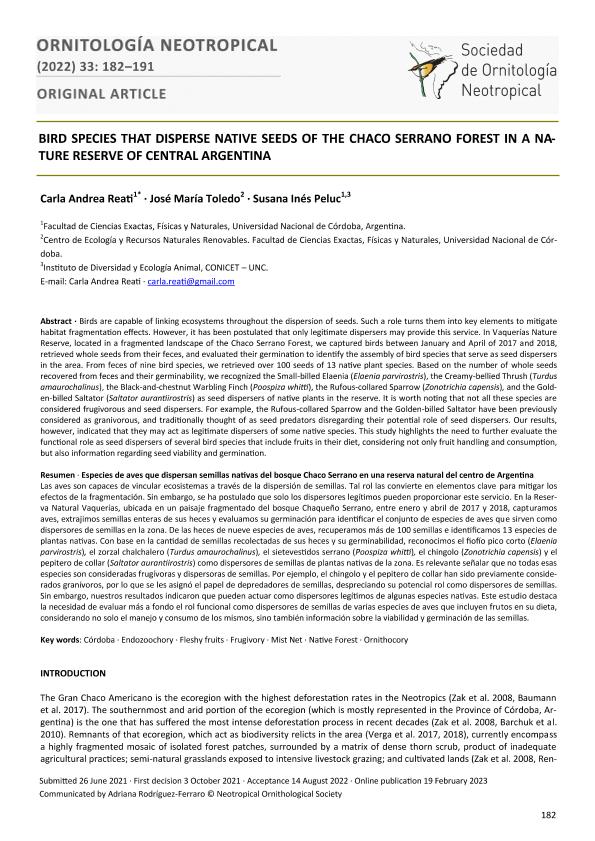Artículo
Las aves son capaces de vincular ecosistemas a través de la dispersión de semillas. Tal rol las convierte en elementos clave para mitigar los efectos de la fragmentación. Sin embargo, se ha postulado que solo los dispersores legítimos pueden proporcionar este servicio. En la Reserva Natural Vaquerías, ubicada en un paisaje fragmentado del bosque Chaqueño Serrano, entre enero y abril de 2017 y 2018, capturamos aves, extrajimos semillas enteras de sus heces y evaluamos su germinación para identificar el conjunto de especies de aves que sirven como dispersores de semillas en la zona. De las heces de nueve especies de aves, recuperamos más de 100 semillas e identificamos 13 especies de plantas nativas. Con base en la cantidad de semillas recolectadas de sus heces y su germinabilidad, reconocimos el fiofío pico corto (Elaenia parvirostris), el zorzal chalchalero (Turdus amaurochalinus), el sietevestidos serrano (Poospiza whitti), el chingolo (Zonotrichia capensis) y el pepitero de collar (Saltator aurantiirostris) como dispersores de semillas de plantas nativas de la zona. Es relevante señalar que no todas esas especies son consideradas frugívoras y dispersoras de semillas. Por ejemplo, el chingolo y el pepitero de collar han sido previamente considerados granívoros, por lo que se les asignó el papel de depredadores de semillas, despreciando su potencial rol como dispersores de semillas. Sin embargo, nuestros resultados indicaron que pueden actuar como dispersores legítimos de algunas especies nativas. Este estudio destaca la necesidad de evaluar más a fondo el rol funcional como dispersores de semillas de varias especies de aves que incluyen frutos en su dieta, considerando no solo el manejo y consumo de los mismos, sino también información sobre la viabilidad y germinación de las semillas. Birds are capable of linking ecosystems throughout the dispersion of seeds. Such a role turns them into key elements to mitigate habitat fragmentation effects. However, it has been postulated that only legitimate dispersers may provide this service. In Vaquerías Nature Reserve, located in a fragmented landscape of the Chaco Serrano Forest, we captured birds between January and April of 2017 and 2018, retrieved whole seeds from their feces, and evaluated their germination to identify the assembly of bird species that serve as seed dispersers in the area. From feces of nine bird species, we retrieved over 100 seeds of 13 native plant species. Based on the number of whole seeds recovered from feces and their germinability, we recognized the Small-billed Elaenia (Elaenia parvirostris), the Creamy-bellied Thrush (Turdus amaurochalinus), the Black-and-chestnut Warbling Finch (Poospiza whitti), the Rufous-collared Sparrow (Zonotrichia capensis), and the Golden-billed Saltator (Saltator aurantiirostris) as seed dispersers of native plants in the reserve. It is worth noting that not all these species are considered frugivorous and seed dispersers. For example, the Rufous-collared Sparrow and the Golden-billed Saltator have been previously considered as granivorous, and traditionally thought of as seed predators disregarding their potential role of seed dispersers. Our results, however, indicated that they may act as legitimate dispersers of some native species. This study highlights the need to further evaluate the functional role as seed dispersers of several bird species that include fruits in their diet, considering not only fruit handling and consumption, but also information regarding seed viability and germination.
Identification of the bird species that disperse native seeds of the Chaco Serrano forest in a nature reserve of central Argentina
Título:
Especies de aves que dispersan semillas nativas del bosque Chaco Serrano en una reserva natural del centro de Argentina
Fecha de publicación:
02/2023
Editorial:
Neotropical Ornithological Society
Revista:
Ornitología Neotropical
ISSN:
1075-4377
Idioma:
Inglés
Tipo de recurso:
Artículo publicado
Clasificación temática:
Resumen
Palabras clave:
Endozoochory
,
Fleshy fruits
,
Frugivory
,
Mist Net
,
Native Forest
,
Ornithocory
Archivos asociados
Licencia
Identificadores
Colecciones
Articulos(IDEA)
Articulos de INSTITUTO DE DIVERSIDAD Y ECOLOGIA ANIMAL
Articulos de INSTITUTO DE DIVERSIDAD Y ECOLOGIA ANIMAL
Citación
Reati, Carla Andrea; Toledo, José María; Peluc, Susana Ines; Identification of the bird species that disperse native seeds of the Chaco Serrano forest in a nature reserve of central Argentina; Neotropical Ornithological Society; Ornitología Neotropical; 33; 2; 2-2023; 182-191
Compartir




